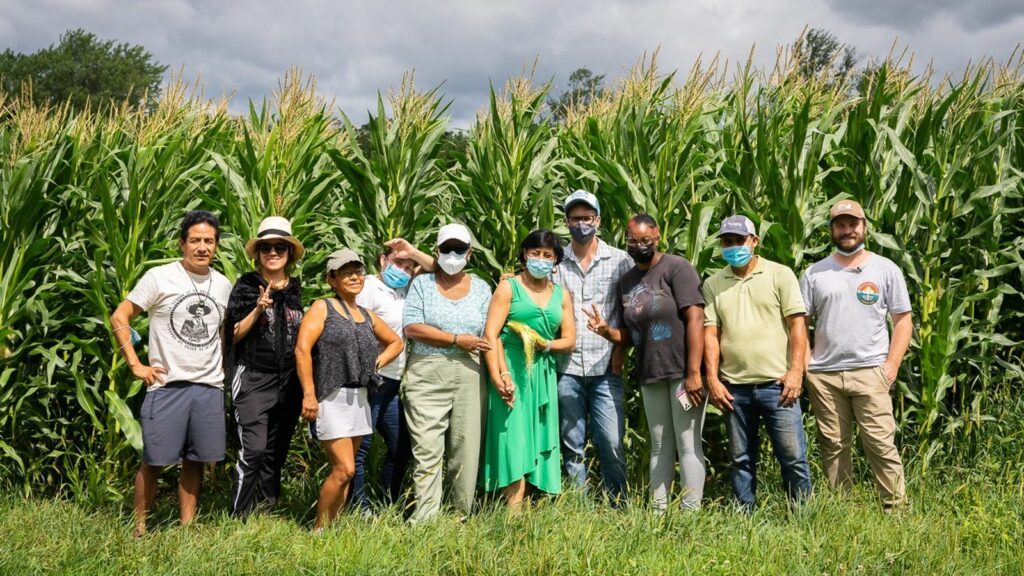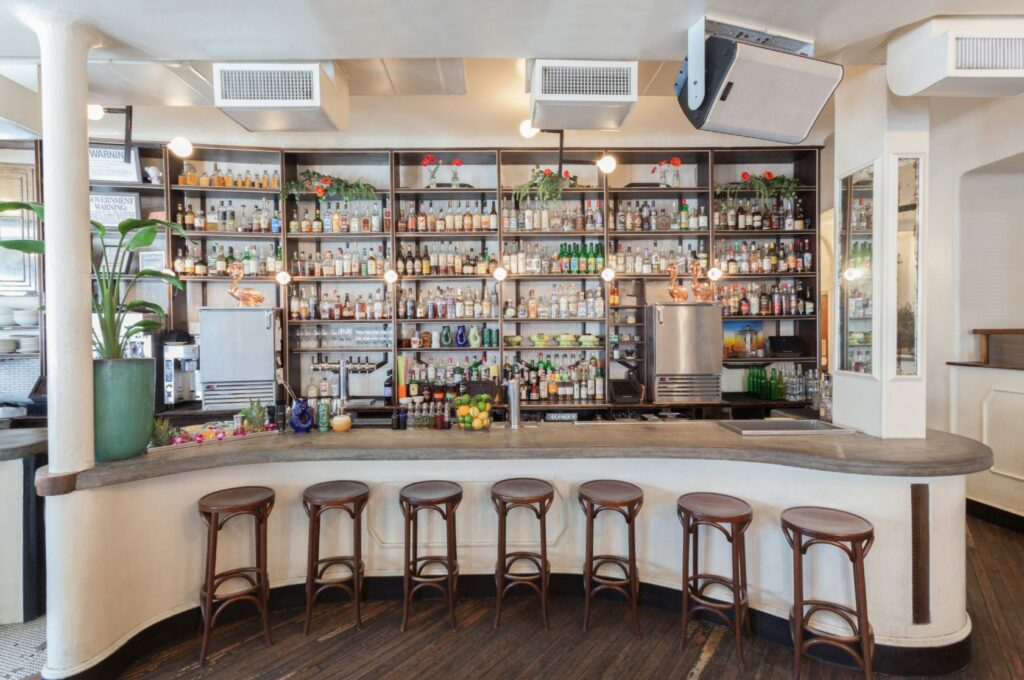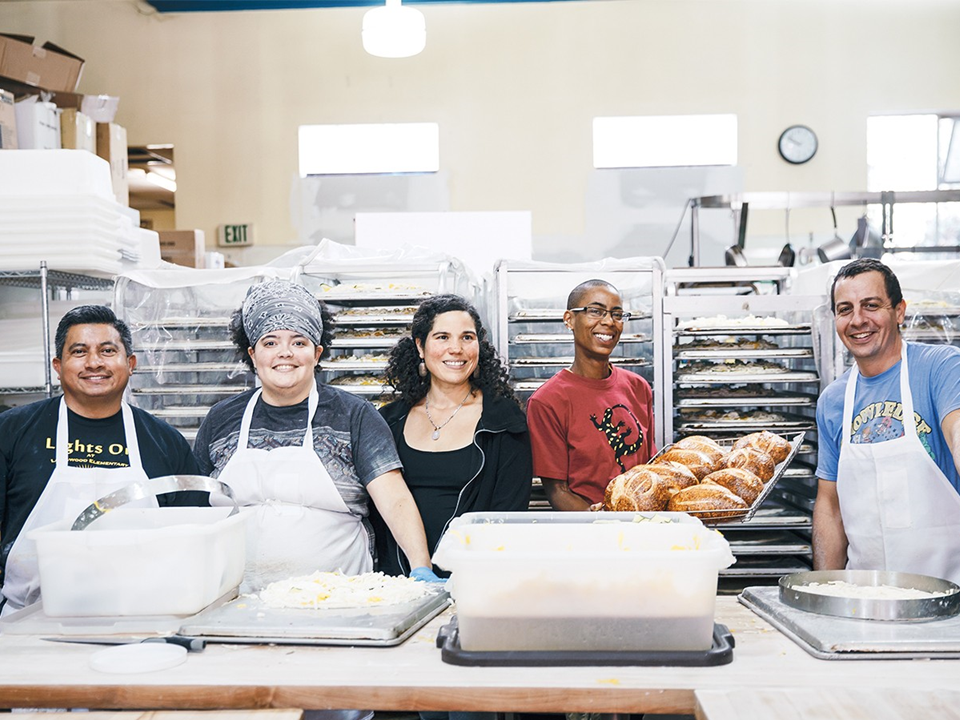This essay is part of our editorial series, Work in Progress on design and restaurant labor.
“Why is it that in conversations about ‘sustainability’ we talk about vegetables but not about people?” Ben Miller of South Philly Barbacoa and Masa Cooperativa asked me. He’s right—look to the list of lauded and celebrated restaurants of any given moment, and it’s almost certain that the pedigreed agricultural origins of the ingredients, not the treatment of a restaurant’s workers, will be the signifiers-of-choice for restaurant morality and equality, and for customer health and wealth. Yes, responsible food origins from land and soil are vitally important, but what about the worker who grew and picked the crops? Or the driver who loaded and delivered the case? Or the prep cook who washed, chopped, and processed them, the line cook who plated the dish, and the food runner who dropped it at your table? Out of the canon of “notable and prestigious” restaurants, projects prioritizing the ecosystem of labor around and within restaurants are few and far between. Fewer still are worker-owned cooperative restaurants. To paraphrase art historian and theorist Linda Nochlin: Why Have There Been No Great Worker-Owned Restaurants? Silly questions deserve long answers.1
- 1. Nochlin’s 4,000-word essay included the (now rarely reproduced) subtitle: ‘Silly questions deserve long answers.’
“Operations = equity” is something I’ve repeated to myself as I’ve worked in kitchens and restaurants over the years, a neat little formula that captures who I think is accountable for the worker experience (Answer: the folks in charge). It stems from my belief that by its very design, operations are the restaurant, and they make or break it. The operational scope covers the team, the workflow, the customer experience, the inventory and ordering, the quality control, and more. At the highest business function, operations intersect with nearly every line item category on the Profit and Loss report (P&L)- revenue, cost of goods sold, expenses. Without properly designed operations, things fall apart badly. And the ones who bear the brunt of that are often the ones who keep it running: the workers. Poor operations can make employees feel like afterthoughts—abandoned, denigrated, unvalued, and less-than. And yet, I’ve been stuck on the fact that those feelings equally saturate the kitchens built on the rigid hierarchy of the classic Escoffier brigade. You know the kind: highly efficient, immaculately laid-out fine dining kitchen systems. The ones of “destination-worthy” ratings and press, of stars and heat maps. They’re also the restaurants that tend to perpetuate not only a particular brand of ego-fueled machismo, but also the “pay your dues” meritocracy: one must work their way up from the lowest paying “grunt work” to management and maybe one day, ownership.
“Ownership” connotes authority, autonomy, and power—a checklist of everything the typical restaurant worker lacks. By and at large, traditional ownership models are structured to give power to a singular owner or small group of owners, e.g. The Boss(es). But rarely is business ownership distributed among many equally, except that is, in a worker-owned cooperative. I’ve been interested in worker-owned cooperatives for a while, especially as an actionable way to improve the restaurant worker experience. A business owned by a group of workers, and both operated and governed equally and laterally between them, the worker-owned co-op commits “One Member, One Vote,” to those who actually work the shifts. Business governance is democratized, rather than the responsibility of just one or two decision-makers or a Board of investors. Critically, the co-op promises a more equitable distribution of profits and wealth. “If you break it down, ownership really involves the benefits that come from ownership,” says Alice Maggio of The Working World, a non-profit that builds cooperative businesses in low-income communities. “A worker-owned cooperative is a company where the people who work there get to access the benefits of ownership, such as profits and participation in decision making.”
Why is it that in conversations about ‘sustainability’ we talk about vegetables but not about people?
Wealth is redistributed in the worker-owned co-op, and the worker-owners reap the benefits of their own labor rather than profits enriching the single owner or company investors. An employee of a co-op’s path to ownership isn’t tied to what wealth they had (or didn’t have) before—it’s decided collectively, as are the specific work conditions. And, in an industry where nearly 10% of all undocumented immigrants in the United States precariously work, the worker-owner model can offer business ownership regardless of citizenship status. Ben Miller, who co-owns South Philly Barbacoa with chef Cristina Martinez, and is a founding member of the 6-person worker-owned Masa Cooperativa, sees the co-op as a culmination of lots of different tangents in their work. “I came to understand that you don’t have to be a citizen in this country to own a business. My wife Cristina’s a business owner, her son was a business owner, and they don’t have papers. There are multi-billionaires who own companies in the United States that are able to make money off of it, and they’re not citizens here” said Ben. Take any number of “Classic American Brands” to see what he means: Budweiser is headquartered in Belgium, Vaseline, Hellman’s mayonnaise and Good Humor ice cream are all headquartered in England, and 7-Eleven is headquartered in Japan. “The worker-owner model allows undocumented workers to be paid legally as owners. So many restaurants are composed of the creativity and hard work of this group of people, but only one person or a couple of people are the main beneficiaries of it. It makes sense for a restaurant to be cooperative because it always is.”

Because it always is. A restaurant doesn’t operate without its workers, structure aside. And when I shared my thoughts about operations design with Maggio, she took it a step further. “You know, the structure of a co-op is a way of legally formalizing what you might hope to happen if you set up operations that are very thoughtful in a traditional business. You could do your very best to make conditions good for your team, but if the sole owner then decides your plan needs to go out the window, then that’s it, it’s out the window, right?” Right. There’s only so much that one can do as an individual employee in a single-owner business, no matter how determined, committed, or motivated they are to do right by their team. A traditional ownership structure means that an employee only has as much of a say as the owner grants them. Someone higher in the ranks might make their decisions based on the recommendation of their at-will employees, or they won’t. The company might sell or pursue an entirely different model at any moment, regardless of their input, as is reasonable for them to do. It’s their business, and they’re on the hook for it.
So why aren’t there more worker-owned restaurants? There are excellent worker-owned food businesses out there, like the well-established Arizmendi bakery or The Cheese Board Collective, both in the Bay Area. Or Cleveland’s Phoenix Coffee, Baltimore’s Red Emma’s and Joe Squared. With the exception of the latter two, many of the prominent worker-owned coops are food producers, grocers, bakeries, or cafés. We’ve had plenty of reckonings and calls to “reimagine” the industry, with radical revisionings of what a restaurant can be. But not so many restaurants are turning to worker-ownership as an answer. “I don’t know that many worker-owned cooperative restaurants, but I don’t think it’s due to anything in particular, except that we just don’t have enough worker-owned cooperatives in the world, period,” offered Maggio, “You don’t see a lot of co-ops of any sort when you walk down the street. There has to be support for a co-op to get started. It doesn’t just happen automatically. That’s why The Working World offers business support along with financing. We are working to address the many structural forces that make it hard for most employees to start their own businesses together.”
The lack of businesses overall that have a worker-owner model also means that there aren’t a lot of examples out there that help business owners understand that its design works. Miller shared a bit of the conversation around converting Barbacoa to a worker-owned coop: “Cristina is the sole proprietor of the restaurant and it’s really her family’s tradition that we cook here at our core. Her recipes are family secrets passed down from generations, and she wanted to protect the one thing that she has. And the cooperative method was unproven to her. She knows that [Barbacoa] is currently working and she’s able to earn a little bit of something for her family and create financial stability. The co-op for her was just a theory, and it was an untested and unproven theory at that.” A new ownership structure without a lot of precedent feels like a huge liability, especially for a business with razor-thin financial margins in an economic context of inflation, supply chain problems, and labor shortages. Other barriers exist, too, from financial lending to securing real estate. Banks want one accountable individual on a loan, not a group. Same goes for landlords and their lease agreements. Venture Capitalists require equity or exponential returns on their investment, both fundamentally at-odds with what a worker-owned cooperative is about. Even employee buy-in can be a barrier. Several of the people I spoke to cited the restaurant industry’s reputation as a transient work environment with a lot of young people, especially in the front-of-house positions like servers, bartenders, or food runners. Although there are many who do see the duration of their professional lives in all areas of the restaurant ecosystem, to get workers committed to becoming the owners of their restaurants might not always be an easy sell.
But the worker-owner cooperative isn’t some idealized monolith or utopic vision. In practice, it’s an extremely flexible way to do business that isn’t even really that different from other common business structures. “In a lot of ways, becoming a worker-owned cooperative is simpler than you would think, because an owner can bring on new owners at any time that they want. There’s lots of ways to do it, too. Cooperative governance and practices can fit well within a number of different corporate structures, including LLC and C-Corp” says Maggio. In converting an existing business to a worker-owned cooperative, The Working World uses a model that combines non-extractive finance- an alternative financial system that seeks to halt “extraction from the many for the benefit of the few”- with business support, to make sure that the business keeps operating as it was before, especially if that worked for them in the past. “You’re trying to transfer it to new owners, to new hands. Along the way, you don’t want to drop it and break it. And you don’t really want to change that much about it. You just want to change who holds it.” Yes, a worker-owned cooperative requires extra steps to implement a structure of bylaws and group owner governance. Yes, it requires a group of people who are on the same page about what ownership—and its accompanying challenges—entails. And yes, it requires support and often guidance on how to implement. But day-to-day operations don’t change that much. Worker-owned cooperatives use all types of familiar leadership structures to get the work done, like electing their own board from their worker-owners, hiring their own management, and organizing into departments. It’s still a for-profit business, after all.
Perhaps the biggest reason why there aren’t more is because we, as restaurant guests and customers, don’t care to investigate the restaurant’s labor as much as we’re interested in their position on any number of buzzy values (see: “farm-to-table” over “worker-owners”). Or perhaps we’re primed to think that the worker-owner model doesn’t work, and that workers don’t want an increased level of responsibility and liability over their jobs. That feels reasonable, to a degree, but this limited perception of ownership is a byproduct of the system we’ve been brought up in, one that values single-ownership and a singular vision. So what about those who are doing it differently?

After eight years of a traditional ownership structure, the bar and restaurant Donna in Brooklyn began the conversion process to worker-ownership in 2020. Donna’s original co-owner Leif Young Huckman framed it to me as the “if it ain’t broke, don’t fix it” conundrum. “But it was broken. And there was a pressure of not wanting to mess with something that was making people money, which it was,” said Huckman. Donna worker-owner Elissa May elaborated, “I didn’t want to pick up where we left off. 2020 exposed so many issues, not just within our industry, but also within our country. We didn’t want to be like, ‘OK, business as usual,’ because ‘business as usual’ didn’t work. We asked, ‘how do we do this and how do we do it better?’”
The eight founding worker-owners of Donna are collectively shaping what their own business is, from work culture to cash flow to benefits. All of them worked at Donna pre-Pandemic, in its original traditional-ownership structure, and all of them were compelled to return and move it together towards a more financially, physically, and emotionally viable place to work. Worker-owner Lauren Ruiz explained, “I know that the ones that stay in the industry and have longevity are the ones that kind of sell out a little bit and work for big restaurant conglomerates and groups. Creatively, those groups don’t grant a lot of leeway, especially for chefs and somms [sommeliers]. But they’re the restaurants that give their employees health insurance and 401Ks. As a collective, we can keep our independent creative freedom while also making decisions to prioritize offering all of the benefits that big corporate restaurants and restaurant groups offer.”
For those who work in restaurants as their career, worker-ownership is a way to shape the priorities that most benefit the workers, with each individual contributing their own unique set of skills, perspectives, and resources. “It’s a different way of looking at and cutting up the pie. And you know what? Potentially, it’s a way of actually making a bigger pie because everybody is truly incentivized. It’s not extractive,” says Huckman. I was struck by Ruiz’s closing words, “Donna’s lightning in a bottle, but we all hold it.” Lots of places are talking about wanting to upend the restaurant industry, many out of a genuine desire and passion to change working conditions. They need to be talking about decentralizing ownership to meaningfully do so. Let us carry it, too.
Interested in learning more about Worker-Owned Cooperatives?
Here are some organizations and communities to get you started, courtesy of Maggio:
For cooperative-focused financing:
- The Working World (local to NYC)
- Seed Commons (US national)
For cooperative networking and support:
- NYC Network of Worker Cooperatives (local to NYC)
- U.S. Federation of Worker Cooperatives (US national)






